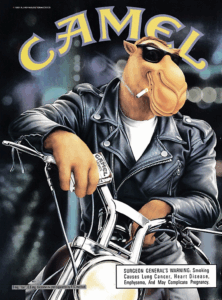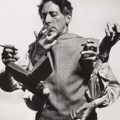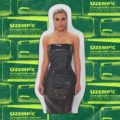
Imagine you’re a kid or teenager in the late 90s. You’re figuring out who you are, experiencing new things, and feeling invincible. Then you see a figure, a figure that symbolizes everything a young teen wants to be. A suave camel, never seen, not looking cool and nonchalant. The mascot is always in a perfectly fitting suit, slick leather jacket, or surrounded by beautiful women. This is Joe Camel. From the outside, it’s a cool figure for a company, a harmless cartoon – but when looking deeper, the art crime is found. A crime of deception crafted by big companies to exploit young children and kids for a profit. Camel cigarettes used this visual design, character, and psychological factors to manipulate teens into thinking of smoking as a fun, rebellious, and glorified activity.
Joe Camel was a marketing campaign for Camel cigarettes that initially began in Europe in 1987. Joe was introduced to the United States in 1988 in celebration of Camel’s 75th anniversary campaign. So, now this mascot is entering the market, catching the attention of new, younger consumers. As seen throughout the history of tobacco in the United States, children and young adults are always interested in whether their favorite celebrity, pop star, or athlete is smoking some new, hip thing. With Joe Camel, kids had a unique type of figure. One that could do no wrong, a fictive man-camel that is always possessing perfect swagger, the Camel cigarette image.
The company even created a rewards system where you, consumers, could redeem points earned by buying cigarettes for merchandise. This merchandise was clearly targeted for children, not of-age smokers. This merchandise was colorful, playful, and childlike. Perfect, to attract Camel cigarettes’ newfound target market.
By the early 1990s, people started to notice that something odd was happening because of this campaign. Numerous studies were conducted to determine if the company, “RJR Nabisco’s cartoon-theme advertising is more effective in promoting Camel cigarettes to children or adults. To determine if children see, remember, and are influenced by cigarette advertising.” In this study, which was conducted on October 21, 1992, the conclusion was found that “Camel’s share of the illegal children’s cigarette market segment has increased from 0.5% to 32.8% representing sales estimated at $476 million per year.”. That is an over 65 times increase since Joe Camel was introduced.
Ultimately, in 1997, the FTC deemed the marketing tactics of Camel cigarettes to be unlawful due to the deliberate attempt to target minors. The company never admitted wrongdoing; however, it is abundantly clear that the general public, government, and most definitely children were victims of this manipulation. This is just another unfortunate example of large, powerful, wealthy companies that are being controlled by people in power, exploiting the general population for their own benefit. A seemingly innocent advertising campaign utilized to unknowingly delve into and control the minds of consumers. This wasn’t just an advertisement tactic; it was a crime that intentionally manipulated children.







